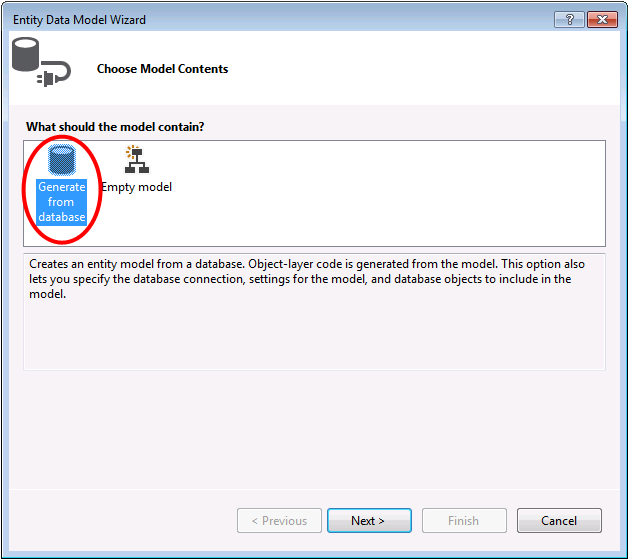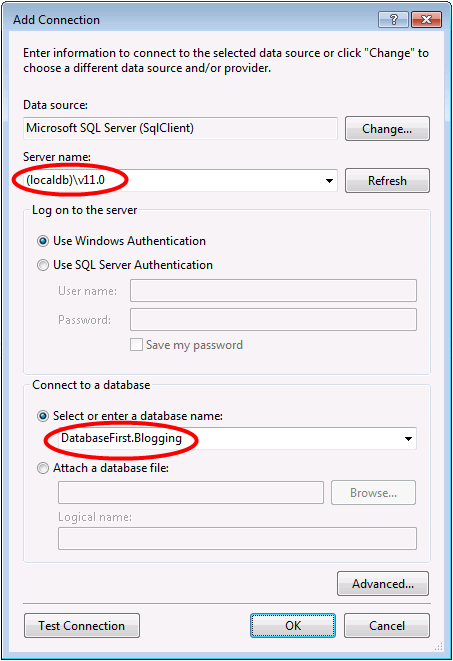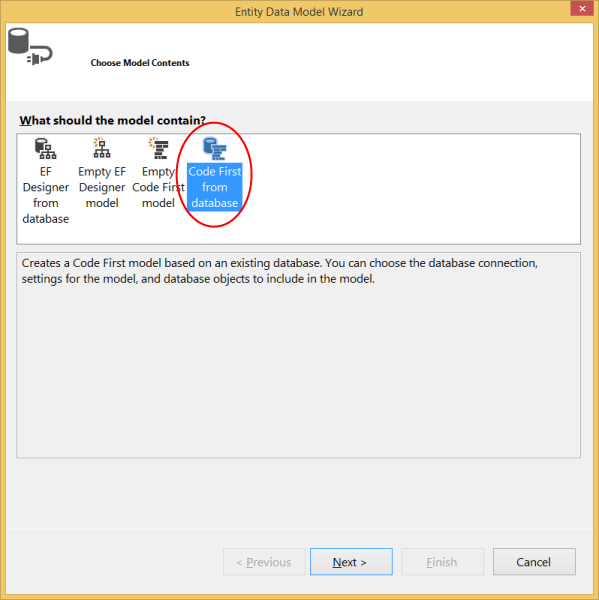Ef 6 Database First Update Model
PARAMETERS -SourceMigration Only valid with -Script. Right click anywhere on that window and select Update Model from Database.

Database First Ef6 Microsoft Docs
The classes that you interact with in your application are automatically generated from the EDMX file.

Ef 6 database first update model. An Update Wizard window appears. He can view the designer but when he goes to Update Model from Database to add anything it does not list any tables. Use the verbose option to view the SQL statements being applied to the target database.
Database First allows you to reverse engineer a model from an existing database. In the properties window you will find the Connection String field. So we need to do reverse engineering using the Scaffold-DbContext command.
After creating a migration file using the add-migration command you have to update the database. Lets create a new empty project and add all the required packages for EF core which is explained in the Code First approach. EF Core does not support visual designer for DB model and wizard to create the entity and context classes similar to EF 6.
Entity Framework EF 61 is the first x update since Microsoft open sourced the tool moving to version 6 and moved it to CodePlex. Step 2 To create the model first right-click on your console project in solution explorer and select Add New Items Step 3 Select ADONET Entity Data Model from middle pane and enter name DatabaseFirstModel in the Name field. Adding a column to a table is reflected but not adding a field to a stored procedure.
The model is stored in an EDMX file edmx extension and can be viewed and edited in the Entity Framework Designer. You can also update your model when the Database changes. Changing the Database and updating its model.
Updates the database to the current model by applying pending migrations. Step 5 Select EF Designer from database and click Next button. The Database First Approach provides an alternative to the Code First and Model First approaches to the Entity Data Model and it creates model codes classes properties DbContext etc from the database in the project and those classes become the link between the database and controller.
Entity Framework code first migrations allows you to create a new database or to update existing database based on your model classes. EF Database First with ASPNET MVC. If the application implements a Migrations Seed method the method runs after the database is created or the schema is updated.
This video and step-by-step walkthrough provide an introduction to Database First development using Entity Framework. Sep 24 2014 0333 PMHaansiLINK. Database First allows you to reverse engineer a model from an existing database.
Code First vs Database First vs Model First EntityFramework Approaches Explained June 26 2021 by Wade 0 Comments When it comes to developers talking about Entity Framework and Im including EF Core in this I find there is very much two camps. Step 6 Select the existing database. Execute the get-help update-database or get-help update-database -detailed command in PMC to know more about the command.
Within the Model Browser in VS 2015 default configuration it is a tab within the Solution Explorer expand Function Imports under the model. Step 4 Click Add button which will launch the Entity Data Model Wizard dialog. In particular it enables you to use clean plain old classes aka POCO for your model objects and cleanly map them tofrom the database using either the default.
Open SQL Sever Object Explorer then right click on the database to open the Properties Window. There is an easy way to find the Database Connection String. Please visit the link below.
This seems to work great except that changes in stored procedures are not reflected when updating or refreshing the model. In Model First you define your model in an Entity Framework designer then generate SQL which will create database schema to match your model and then you execute the SQL to create the schema in your database. Creating entity context classes for an existing database is called Database-First approach.
To create a DbContext and classes from the existing database we will run the Scaffold-DbContext command in Package Manager console. The classes that you interact with in your application are automatically generated from the EDMX. Expand the Tables Views and Stored Procedures nodes and check the objects you want to add to the edmx file.
I have shown this in. Simply copy its value from there. I add a EF Model to the project adding some tables and commit the project.
Specifies the name of a particular migration to use as the updates starting point. Execute the Update-Database command to create or modify a database schema. We are using Entity Framework 600 and use database first like this to generate code from tables and stored procedures.
Following is a simple example of. Now Entity Framework6 code first migrations is able to manage multiple DbContext per physical database instance. Save that edmx file.
It will syncrefresh your Model base on the changes on your database. Double-click your stored procedure. The model is stored in an EDMX file edmx extension and can be viewed and edited in the Entity Framework Designer.
How to update model working with EF code first with Code First from Database. Schema first EF generation. EF Code First works great with existing databases and enables a very nice code-centric development approach with them.
Now we need to run the scaffold-dbcontext command with just the required parameters. Entity Framework5 code first migrations is only able to manage a single DbContext per physical database instance. Click Finish to update your model.
Update Model From Database. It features tooling consolidation that extends the ADONET Entity Data Model wizard to support creating Code First models including reverse engineering from an existing database Microsofts Rowan Miller explained in an ADONET Blog post. Lets add AuthorName column to the database.
Click the Update button next to Returns a Collection Of - Complex if not returning a scalar or entity. My coworker updates the project and gets the edmx. In your edmx rt-click and select Model Browser.
If omitted the last applied migration in. To update model from the database right-click the edmx file and select Update Model from Database. Using EF Code-First with an Existing Database.
If theres a mismatch Code First automatically creates the database if it doesnt exist yet or updates the database schema to the latest version if a database exists but doesnt match the model.

Database First Ef6 Microsoft Docs

Code First To An Existing Database Ef6 Microsoft Docs

Database First Ef6 Microsoft Docs

Model First Ef6 Microsoft Docs
Posting Komentar untuk "Ef 6 Database First Update Model"